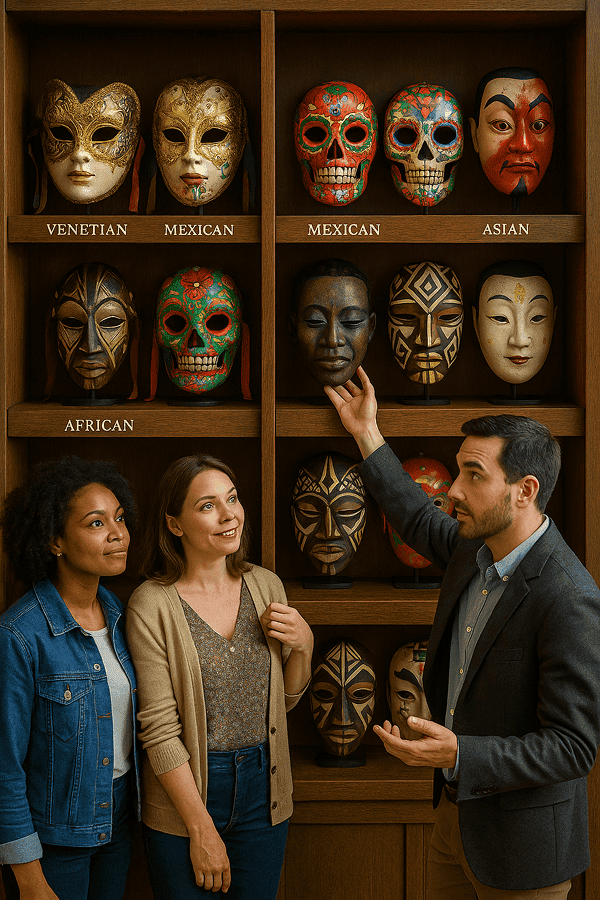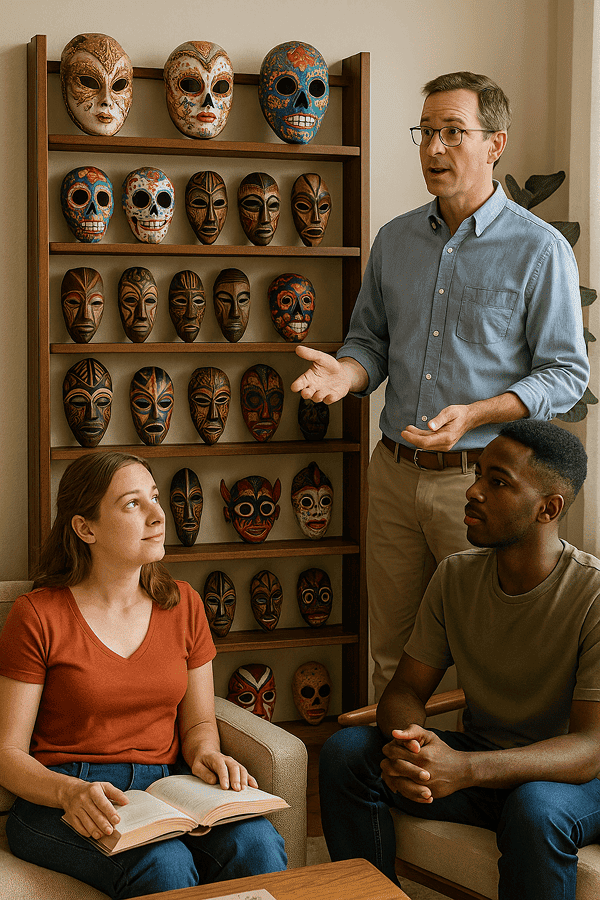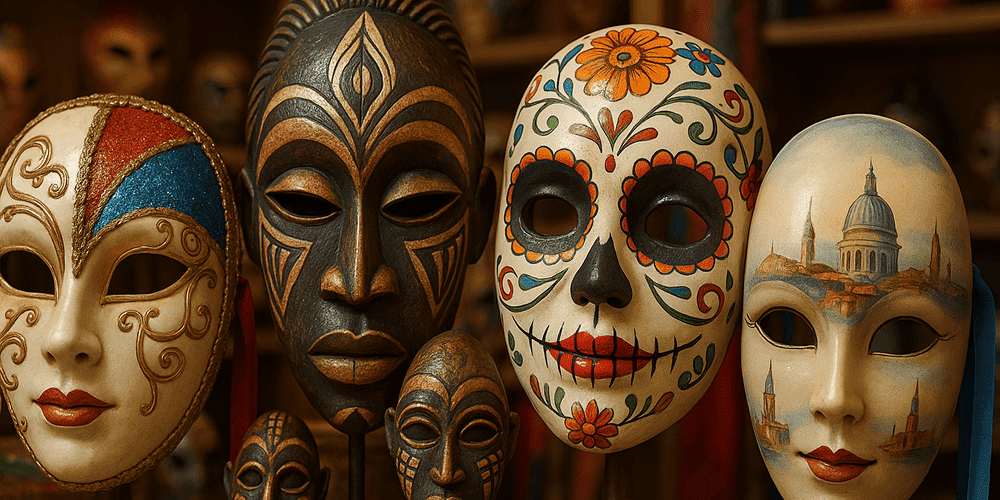Decorative Souvenir Masks are miniature works of art, designed to capture the spirit and culture of a place or tradition, and serve as tangible memories for travelers and collectors. These masks are often characterized by their compact size, vibrant colors, and attention to regional detail. They may replicate the styles of traditional ceremonial or festival masks but are usually made in a format suitable for display in homes, offices, or as gifts. Decorative Souvenir Masks are produced and collected worldwide, representing diverse cultures from Venice and Mexico to Africa, Asia, and the Americas. Today, they are a symbol of global connection, cultural appreciation, and personal storytelling — and for those interested in decor, they are closely related to Interior Design Masks, which offer a larger-scale decorative impact (see more at toddmasks.com).
Historical Origins of Decorative Souvenir Masks
The tradition of mask souvenirs emerged alongside the rise of global travel in the 18th and 19th centuries, as explorers and tourists began to bring home small, portable versions of local masks as mementos. The word “souvenir” is French for “memory” or “remembrance,” and masks have long been associated with rituals, festivals, and folklore. Early souvenir masks were often hand-carved or painted by local artisans, reflecting both the artistic traditions and the commercial needs of the tourism industry.
By the 20th century, the production of souvenir masks expanded rapidly, with workshops and cooperatives in Venice, Mexico, Bali, and West Africa creating affordable and collectible pieces for visitors. The evolution in design has ranged from faithful miniatures of ceremonial masks to playful, stylized, or even humorous interpretations. Today, souvenir masks continue to evolve in response to changing tastes, trends, and the growth of online marketplaces.
Cultural Significance and Symbolism of Decorative Souvenir Masks
Souvenir masks are not just decorative items; they carry rich layers of meaning from their cultures of origin. In their native context, masks often represent ancestral spirits, deities, historical figures, or mythological beings. When crafted as souvenirs, these motifs are preserved and shared globally, helping to spread cultural awareness and appreciation.
Symbolically, a souvenir mask may serve as a token of good luck, protection, or celebration, depending on its design and origin. Myths and legends are often woven into the imagery — from Venetian tales of intrigue to African stories of transformation and Mexican Day of the Dead symbolism. Socially, giving or displaying a souvenir mask can represent friendship, hospitality, or a shared travel experience.
Materials and Crafting Techniques of Decorative Souvenir Masks
Decorative Souvenir Masks are made using a wide range of materials, chosen for affordability, durability, and ease of transport. Common materials include:
- Painted wood and carved bamboo
- Molded or hand-painted ceramics and porcelain
- Papier-mâché and resin composites
- Metal, glass, and beadwork
- Textiles, leather, and natural fibers
- Plaster, plastic, and sometimes recycled materials
The crafting process often involves:
- Designing a miniature version of a traditional mask
- Carving, molding, or casting the base
- Painting, glazing, or staining for vivid color
- Adding decorative elements such as feathers, beads, ribbons, or metallic leaf
- Attaching strings, magnets, or stands for display
Regional differences are pronounced: Venetian souvenir masks use gold and silver leaf with baroque patterns, Mexican masks feature bold colors and festival motifs, African masks often showcase geometric patterns and earthy tones, and Asian masks may include lacquer, gold, or intricate brushwork. Color symbolism is adapted for the souvenir market, but traditional meanings (e.g., red for life, white for spirit, gold for prosperity) are often retained.

Functions and Uses of Decorative Souvenir Masks
The primary function of a Decorative Souvenir Mask is commemorative and decorative, but their uses can be diverse:
- Gifts and tokens: Given to friends, family, or colleagues as a reminder of a journey or event.
- Collectibles: Sought by travelers and art lovers as part of themed or global collections.
- Interior decoration: Used in wall displays, shadow boxes, or as accents in living and work spaces.
- Cultural education: Employed as teaching tools in schools and museums to introduce world traditions.
- Festival or holiday decoration: Sometimes incorporated into seasonal displays or party themes.
While they are not typically used for ritual or theatrical performance, some souvenir masks are functional and can be worn at festivals, parades, or themed events.
Regional Variations of Decorative Souvenir Masks
Decorative Souvenir Masks reflect a rich tapestry of styles from around the world:
- Venetian souvenir masks: Miniature versions of Bauta, Colombina, and Volto, adorned with metallic paint, lace, and feathers.
- Mexican masks: Day of the Dead skulls, animal faces, and folk characters in bright, festive colors.
- African souvenir masks: Miniature wood carvings, geometric patterns, and symbolic animal motifs.
- Asian masks: Japanese Noh and festival masks, Balinese Barong, and Chinese opera faces in lacquered or painted formats.
- South American masks: Peruvian and Bolivian festival masks, often featuring intricate beadwork or textiles.
Every region adapts its traditional motifs, techniques, and color palettes for the souvenir market, resulting in a dazzling diversity of collectible masks.
Famous Examples and Notable Collections of Decorative Souvenir Masks
Notable examples of Decorative Souvenir Masks can be found in:
- Museums: The Victoria and Albert Museum (London), The International Museum of Folk Art (Santa Fe), and Museo Nacional de Antropología (Mexico City) often feature souvenir mask collections.
- Private collections: Many travelers and art lovers build global mask galleries, sometimes focused on a single region or festival.
- Artisan cooperatives and specialty shops: Venice, Oaxaca, Bali, and Dakar are renowned for their souvenir mask markets.
- Online galleries: Platforms like toddmasks.com provide digital exhibitions and expert commentary on notable souvenir masks.
Historic finds include early 20th-century travel souvenirs, artist-signed miniatures, and masks commemorating major cultural events.
Influence of Decorative Souvenir Masks on Art and Culture
Decorative Souvenir Masks have a lasting influence on art, design, and cultural exchange. Their motifs inspire visual artists, illustrators, and designers, while their portability has helped spread world mask traditions to new audiences. In literature and film, souvenir masks often serve as symbols of travel, discovery, or memory.
In contemporary design, souvenir masks are integrated into eclectic, global-inspired interiors and can influence trends in color, pattern, and form. Their popularity has also encouraged the preservation and revival of traditional mask-making skills, fostering respect for world crafts.

Contemporary Status and Preservation of the Souvenir Mask Tradition
The tradition of crafting and collecting Decorative Souvenir Masks is thriving in the modern era. Artisans blend traditional methods with new materials, digital design, and eco-friendly innovations. Workshops, cultural festivals, and online platforms like toddmasks.com support education, appreciation, and global sharing.
Modern adaptations include themed souvenir sets, collaborations with contemporary artists, and interactive or augmented reality masks for digital collectors. Museums and cultural organizations play a key role in documenting and exhibiting souvenir mask traditions, ensuring their preservation for future generations.
Collecting and Acquiring Decorative Souvenir Masks
The market for Decorative Souvenir Masks is active and accessible. Masks can be found at artisan markets, museum shops, cultural festivals, specialty boutiques, and reputable online platforms such as toddmasks.com. Prices range from inexpensive travel mementos to collectible artist-signed pieces.
Tips for collectors:
- Seek authentic, hand-crafted masks with regional features
- Support local artisans and fair-trade initiatives
- Avoid mass-produced or counterfeit items
- Consider provenance, documentation, and display methods
- Respect cultural context, especially for masks with ongoing ritual significance
Collectors often combine souvenir masks with other decorative objects, such as Interior Design Masks, to create unique and meaningful displays.
